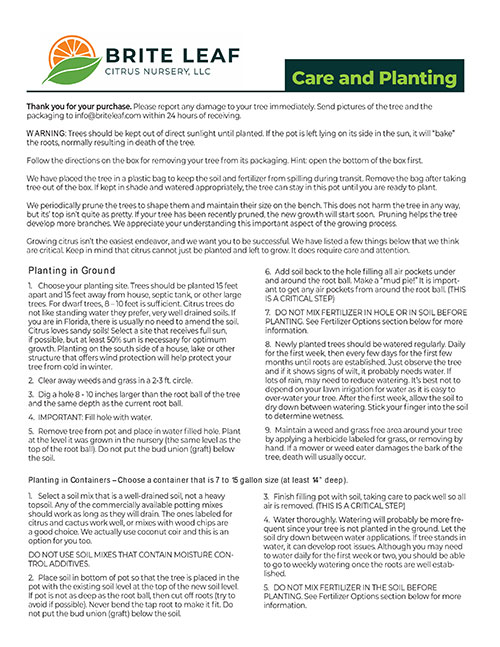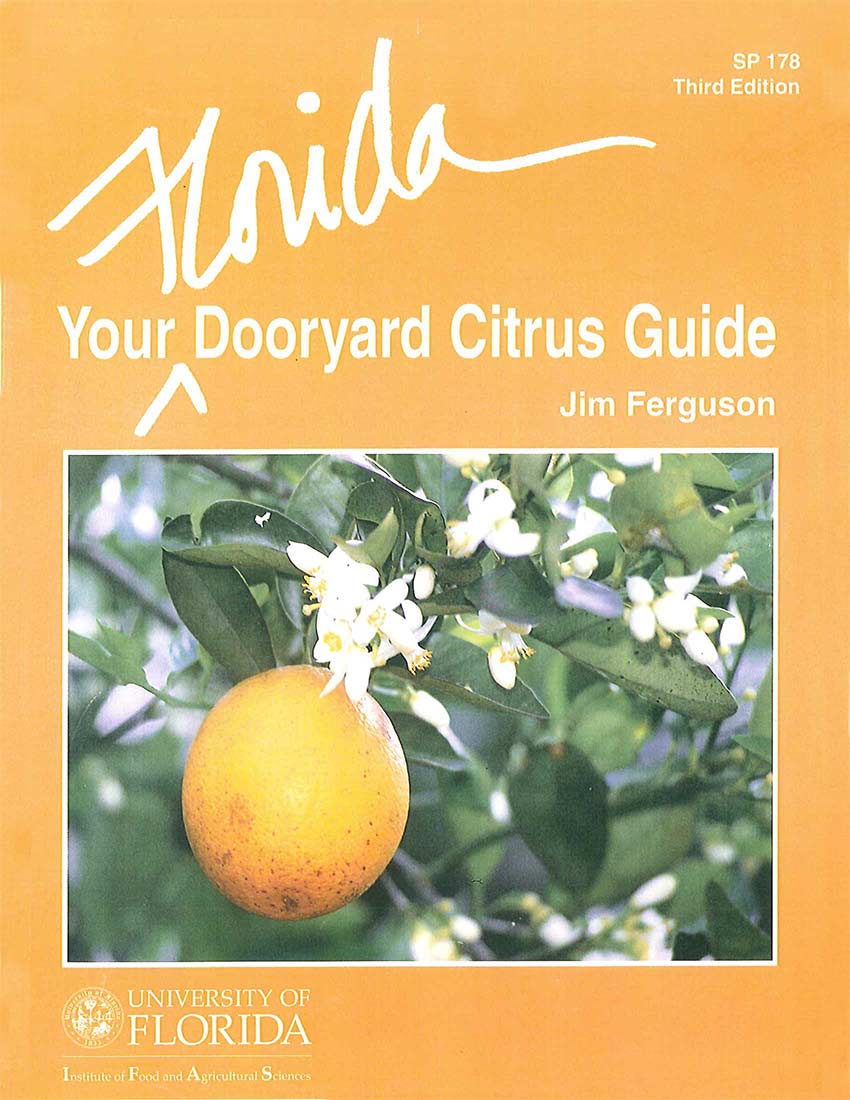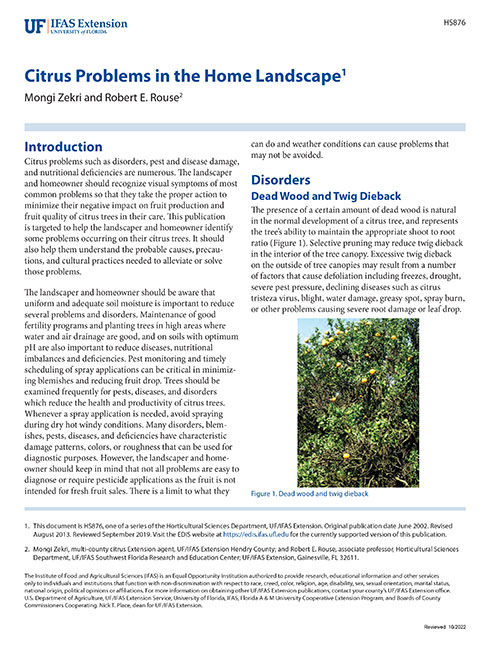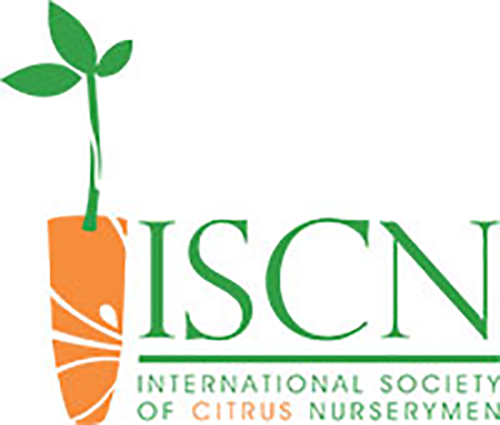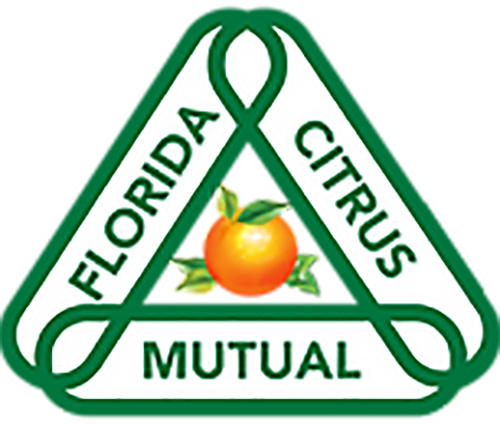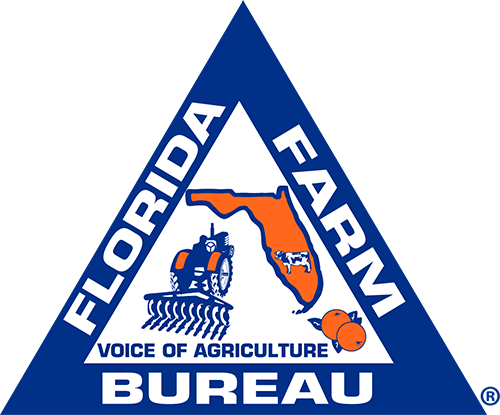Learn to Care for Your Citrus Tree
We at Brite Leaf Citrus Nursery want your trees to be healthy to enjoyment, beauty and fruit for years to come. We have gathered helpful information for you to download to help you care for your trees.
The first PDF is our Care and Planting Guide.
Next is a comprehensive document, Your Florida Dooryard Citrus Guide by Jim Ferguson and the University of Florida. We have links to separate PDFs by subject, then a PDF of the entire guide at the bottom.
Introduction - HS 884
Cold Tolerance - HS 885
Site Selection - HS 886
Young Tree Care - HS 887
Bearing Trees - HS 888
Pruning - HS 889
Common Pests, Diseases, Disorders - HS 980
Appendices - HS 891
Florida Citrus Harvesting Periods
Citrus Greening
Citrus Canker
Your Florida Dooryard Citrus Guide (Complete document)
Another helpful PDF document is Citrus Problems In The Home Landscape.
In addition to the PDF link above, the webpage with the information can be found HERE.
Where to plant your citrus tree
Citrus trees are subtropical plants. They can survive temperatures of 28 degrees F for several hours without permanent damage. Most will not survive temperatures below 28 degrees F for any significant duration.
If you live in USDA Hardiness Zone 8, you may be able to, depending on your location and the variety you choose, plant your citrus tree outside. However, you will need to protect your tree from frost and freezing during extreme cold periods.
If you live in USDA Zone 7 or North, for survival of your tree, we strongly recommend you plant in a movable container which will allow you to move your citrus tree indoors during the winter. You can be as creative as you like in finding a pot for your tree. It can be decorative or just functional as long as it has good drainage.
How to plant your citrus tree
Planting in Ground
1. Choose your planting site. Trees should be planted 15 feet apart and 15 feet away from house, septic tank, or other large trees. For dwarf trees, 8 – 10 feet is sufficient. Citrus trees do not like standing water they prefer, very well drained soils. If you are in Florida, there is usually no need to amend the soil. Citrus loves sandy soils! Select a site that receives full sun, if possible, but at least 50% sun is necessary for optimum growth. Planting on the south side of a house, lake or other structure that offers wind protection will help protect your tree from cold in winter.
2. Clear away weeds and grass in a 2-3 ft. circle.
3. Dig a hole 8 – 10 inches larger than the root ball of the tree and the same depth as the current root ball.
4. IMPORTANT: Fill hole with water.
5. Remove tree from pot and place in water filled hole. Plant at the level it was grown in the nursery (the same level as the top of the root ball). Do not put the bud union (graft) below the soil.
6. Add soil back to the hole filling all air pockets under and around the root ball. Make a “mud pie!” It is important to get any air pockets from around the root ball. (THIS IS A CRITICAL STEP)
7. DO NOT MIX FERTILIZER IN HOLE OR IN SOIL BEFORE PLANTING. However, you can fertilize the same day. See Fertilizer Options section below for more information.
8. Newly planted trees should be watered regularly. Daily for the first week, then every few days for the first few months until roots are established. Just observe the tree and if it shows signs of wilt, it probably needs water. If lots of rain, may need to reduce watering. It’s best not to depend on your lawn irrigation for water as it is easy to over-water your tree. After the first week, allow the soil to dry down between watering. Stick your finger into the soil to determine wetness.
9. Maintain a weed and grass free area around your tree by applying a herbicide labeled for grass, or removing by hand. If a mower or weed eater damages the bark of the tree, death will usually occur.
Planting in Containers
Choose a container that is 7 to 15 gallon size (at least 14” deep).
1. Select a soil mix that is a well-drained soil, not a heavy
topsoil. Any of the commercially available potting mixes should work as long as they will drain. The ones labeled for citrus and cactus work well, or mixes with wood chips are a good choice. We actually use coconut coir and this is an option for you too.
DO NOT USE SOIL MIXES THAT CONTAIN MOISTURE CONTROL ADDITIVES! These will cause death of your citrus tree.
2. Place soil in bottom of pot so that the tree is placed in the pot with the existing soil level at the top of the new soil level. If pot is not as deep as the root ball, then cut off roots (try to avoid if possible). Never bend the tap root to make it fit. Do not put the bud union (graft) below the soil.
3. Finish filling pot with soil, taking care to pack well so all air is removed. (THIS IS A CRITICAL STEP)
4. Water thoroughly. Watering will probably be more frequent since your tree is not planted in the ground. Let the soil dry down between water applications. If tree stands in water, it can develop root issues. Although you may need to water daily for the first week or two, you should be able to go to weekly watering once the roots are well established.
5. DO NOT MIX FERTILIZER IN THE SOIL. It should be placed on top spread around the container, not piled up next to the trunk.
Fertilizer Options
You can spread fertilizer on the ground around the tree the same day you plant. Your trees will come with a small amount of slow-release fertilizer to hold it until you can get it planted. Be sure to follow the manufacturer’s instructions for the product that you choose. Fertilizer should be applied around drip line of tree not up next to the trunk.
a. Choose a citrus fertilizer that contains minor elements, not just N-P-K. Minor elements are the key to a good citrus fertilizer. Minor element deficiencies usually show up first.
b. Only use a fertilizer that you spread on top of the soil or mix in water. DO NOT USE SPIKE TYPES!
c. Generally, for standard, granular types, fertilize at least every 3 – 4 months (avoiding the winter if you are growing outside) usually using 1 – 2 lbs. per year of growth. We recommend fertilizing more often with a reduced rate (you like to eat regularly too).
d. You can also use slow or controlled release fertilizer which would be applied less often. This is a great option for
container trees.
e. You can also opt for water soluble fertilizer where you mix with water and apply each time you water the plant.
We really like this option and is what we do in the nursery. Another great option for container trees.
Sprouts on Grafted Trees
Whether in a container or the ground, any sprouts that develop on grafted trees from the soil line up about 12 – 18” should be removed while young and tender. This way you maintain the trunk, and also don’t allow rootstock sprouts to grow.
Rooted Cuttings
Rooted cuttings were grown without a rootstock to protect it from soil diseases are not suitable for planting in the ground. They are intended for container growing only. Plant same as above, and water well. Monitor for water needs every few days. Follow fertilizing instructions above. They are intended to be a bushy plant, but you can prune them to shape as desired.
Cold Weather Care
While some citrus varieties are cold tolerant, most citrus is not. Citrus is a sub-tropical plant. Regardless of where you live, it may be necessary to protect your tree during freezing conditions, especially the first year.
For containerized plants, if possible, move indoors to garage or warmer spot if there is the possibility of a frost or freeze.
Trees should be well hydrated before a freeze. Plan to water very heavily the day before freezing temperatures are expected. Some leaf droppage can be expected following a freeze, but this should be a temporary situation.
If a freeze is forecasted with temperatures below 32°F, cover the tree with a frost cloth or blanket, never use plastic if it could touch the tree. Coverings should be removed when outside temperatures reach 45°F. If several freezing nights are expected, you can build a “mini-greenhouse” out of PVC pipe around your tree and then cover with blankets or plastic. This would not have to be removed until cold weather was past. Just don’t let the covering touch the leaves. A heat lamp could be added if temperatures will fall below 28°F for more than 2 hours.
NEVER prune the tree after a hard freeze until the new growth is well underway. If no new growth appears by late spring, the tree has sustained severe damage. Any new growth above the graft is new flush and is a good sign the tree has survived the freeze and should continue to produce. Any new growth below the graft (bud union) will be citrus rootstock and should be removed.
Spraying
Many people choose not to spray their trees and we understand and appreciate this. However, there are several insects and diseases that affect citrus that spraying will help inhibit.
1. Leaf miners are a very small insect that lays its larvae under the cuticle of the leaf. These larvae “mine” through the leaf leaving ugly serpentine marks that turn brown and curl the leaf. This can be alleviated by applying Neem Oil or Citrus Spray Oil. Dish soap and water is also an effective deterrent, but you will have to apply more frequently.
2. A systemic product like BioAdvanced Fruit, Citrus and Vegetable will give longer protection for leaf miner and also help protect trees from damage of the Asian Citrus Psyllid which transmits Greening Disease.
3. Fungicides are sometimes needed to control things like Post Bloom Fruit Drop and Greasy Spot.
4. Always spray in the morning or late afternoon, not in the middle of the day. Sprays can cause burn on the leaves.
We are NOT a retail nursery, so do not have open visiting hours. We are not staffed to accommodate drop in visits. Please call before coming to pickup an order.
Due to the diseases that affect citrus trees, we cannot let visitors inside the greenhouses to select trees. We appreciate your respect of our rules to protect our livelihood.

